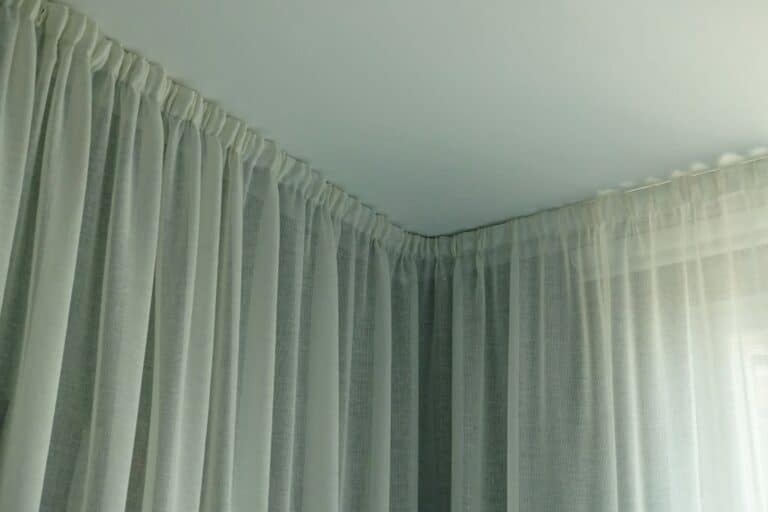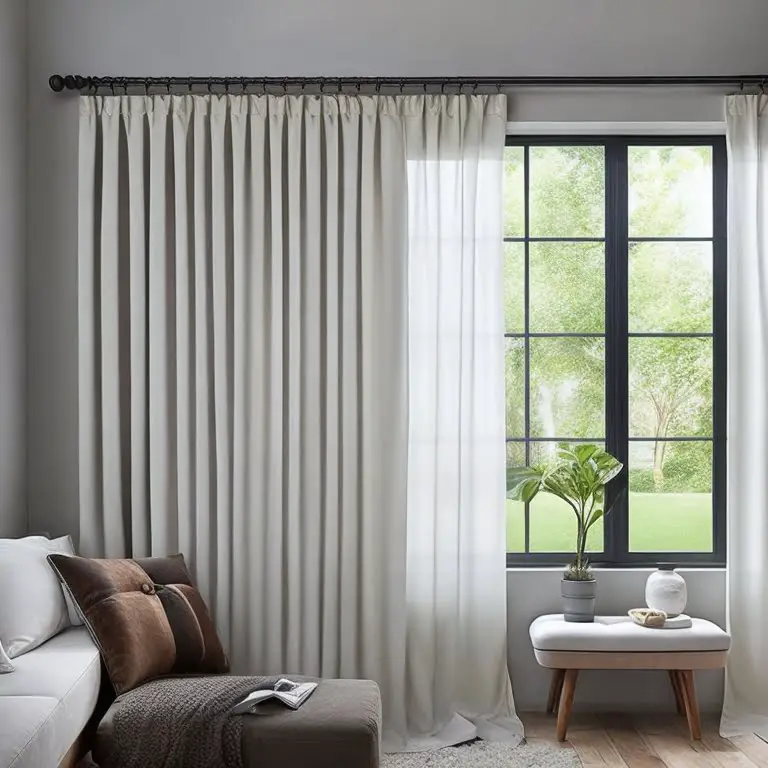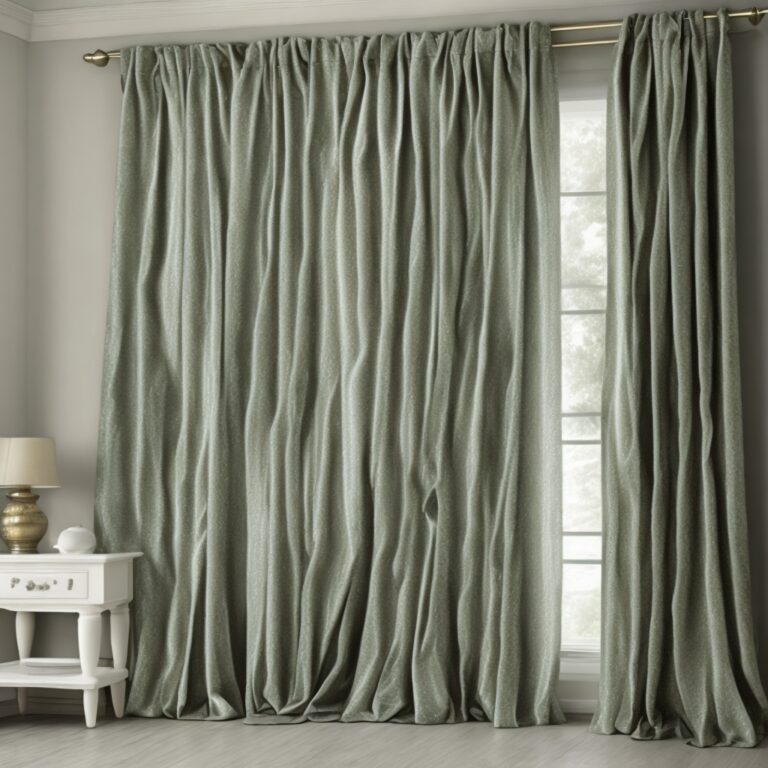How to Hang Curtains from a Slanted Ceiling?: Tips and Tricks
Do you have a slanted ceiling in your room? Have been wondering how to hang curtains on it without making it look awkward and off-balance? Don’t worry—we’ve all been there. Hanging curtains from angled walls or slanted ceilings can be a daunting task, but with the right strategies and techniques, it is totally achievable.
In this blog post, we’ll show you exactly how to hang curtains perfectly on an incline so that they look both elegant and functional. We’ll go through everything from the hardware selection process to the installation methods so that at the end of this blog, you will know exactly how to hang curtains just like an interior designer would.
Ready? Let’s get started ”How to hang curtains from a slanted ceiling?”
How to hang curtains from a slanted ceiling?

Hanging curtains from a slanted ceiling can be a bit of a challenge, but with the right tools and techniques, it’s a task that anyone can accomplish. Whether you’re looking to add a decorative touch to your bedroom or block out light in your home office, curtains are a great way to do so, but they require more effort and attention to detail when dealing with slanted ceilings.
Here are some creative and practical steps to help you get started:
Step 1: Measure the height of the ceiling
Measuring the height of the ceiling is a crucial step before you can successfully hang curtains from a slanted ceiling. A properly measured height will enable you to determine the perfect length of curtains that would fit your walls and cover them effectively without leaving any gaps. To begin, grab a reliable measuring tape and place it at the highest point of the slanted ceiling. You should note that the highest point of the ceiling is where it begins to slant downwards, and not the peak of the ceiling. This is especially important when installing drywall on a slanted ceiling.
Next, bring the measuring tape down all the way to the bottom of the wall where the curtains will be fixed. Ensure that you take the measurement from both the left and right sides to determine if there are any irregularities on the walls that may require adjustments in curtain length.

Write down the measurement on a piece of paper or any other writing material, and be cautious to get the exact figures as any discrepancies will affect the length of the curtains, leaving out gaps or overlapping areas. If you are using a corner curtain rod, make sure to measure the distance from the corner to the end of the wall to ensure a perfect fit that accommodates the width of your window.
It is essential to add an extra inch to the measurement to provide enough room for ample coverage for your windows and to prevent light seepage through gaps. This extra allowance that you have added would be beneficial because you can always adjust the curtains if necessary. It also ensures that the curtains meet the wall at full length and provide an aesthetically pleasing and symmetrical appearance, especially if you opt for longer curtains. With these steps in mind, you can proceed to hang your curtains with confidence and enjoy a beautiful and functional window treatment.
Step 2: Determine the placement of the rod
When considering the placement of the rod for curtains on a slanted ceiling with a vaulted ceiling, it is essential to take several factors into account, including the slope of the ceiling and the high ceiling. First and foremost, you’ll want to ensure that the rod is installed at a height that will allow the curtains to hang freely without touching the ceiling. However, it is also important to determine the appropriate distance from the wall or floor to ensure that the curtains will drape properly and not bunch up or become uneven.
To determine the ideal placement of the rod, it may be helpful to hold up the rod to the ceiling and move it around the space until you find a suitable spot with studs. Pay attention to the angle of the ceiling and any nearby fixtures or furniture that could impact the placement of the rod. Additionally, consider the length and weight of the curtains themselves, as heavier curtains may require a more robust support system. Using a tape measure can also help ensure accurate placement.
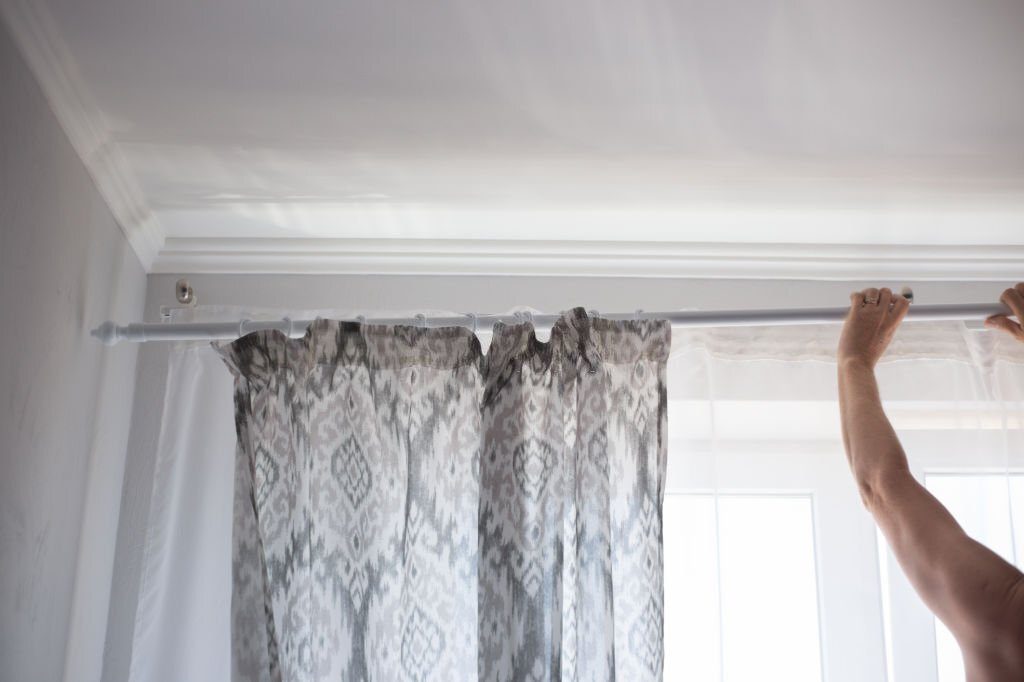
Once you have determined the best placement for the rod, mark the location with a pencil so that you can drill holes and secure the rod in place. Hanging curtains on a slanted ceiling may require specialized hardware or mounting techniques, so be sure to consult the manufacturer’s instructions or seek professional assistance if needed.
With careful planning and attention to detail, you can ensure that your curtains hang beautifully and functionally from a slanted ceiling, adding style, privacy, and decoration to your space.
Step 3: Install the rod brackets
Firstly, ensure that you have selected the optimal position for the brackets on the wall by aligning them with the measurements taken from step one. Once you have selected the ideal position, mark the location of the two holes on the wall using a pencil. For a finishing touch, consider adding custom-made curtains to complement your newly installed brackets.
Using self-adhesive wall hooks, carefully attach the shower rod securely to the wall. If you prefer to use screws, using a power drill, carefully create two holes in the wall that align with your markings. Be sure to use the appropriate drill bit size for your screws and avoid applying excessive force that may cause damage to your wall. Once the holes are made, insert the screws and attach the shower rod and shower curtain securely to the wall.
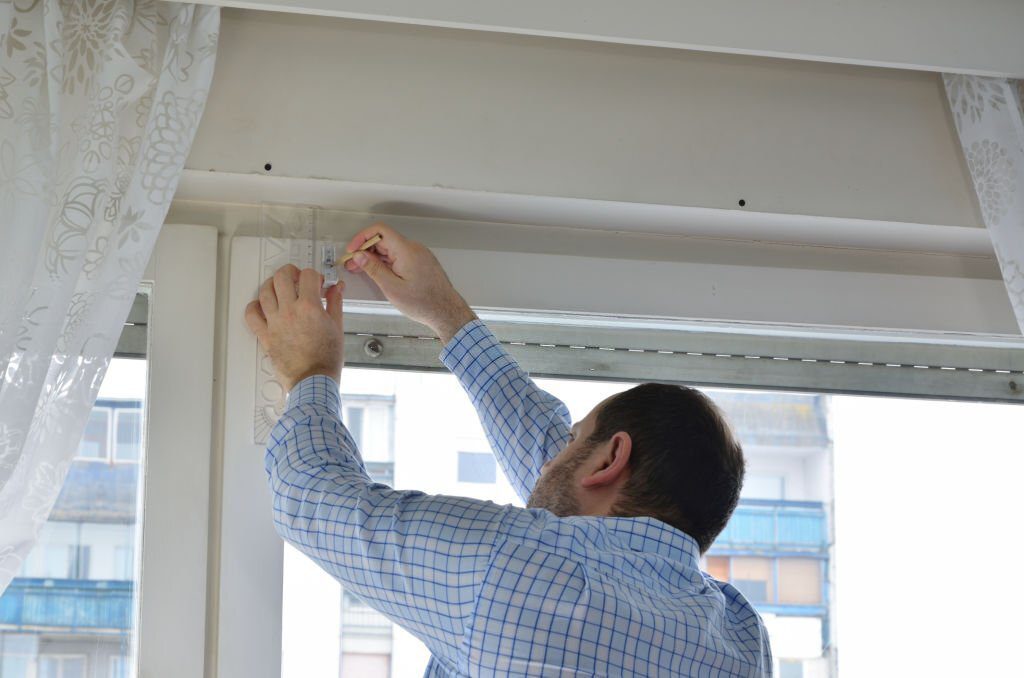
Next, take the rod bracket and position it over the holes, ensuring that it is level and centered accordingly. You may need to use a leveler tool to achieve the perfect alignment. Once the bracket is in the desired position, use the provided screws to securely fasten it to the wall.
Ensure that the screws are positioned at an equal distance from the center of the window to prevent the curtain from hanging crookedly. If you are hanging curtains from a slanted ceiling, be sure to adjust accordingly and ensure that the curtain rod brackets are level, even if the ceiling is not.
With the rod brackets securely in place, you have found the perfect solution for hanging your curtains stylishly and seamlessly with a straight end.
Step 4: Attach the rod
Now that you have securely fastened the brackets to the wall, it’s time to attach the rod. Begin by taking the rod and inserting it through the holes in the brackets. Make sure the rod is level by using a measuring tape or leveler. This is particularly important if you’re dealing with a slanted ceiling.
Once you’re confident that the rod is level, it’s time to tighten it in place using screws. Take caution not to over-tighten the screws as this may cause the rod to snap or damage the brackets. Simply tighten the screws enough to hold the rod securely in place.
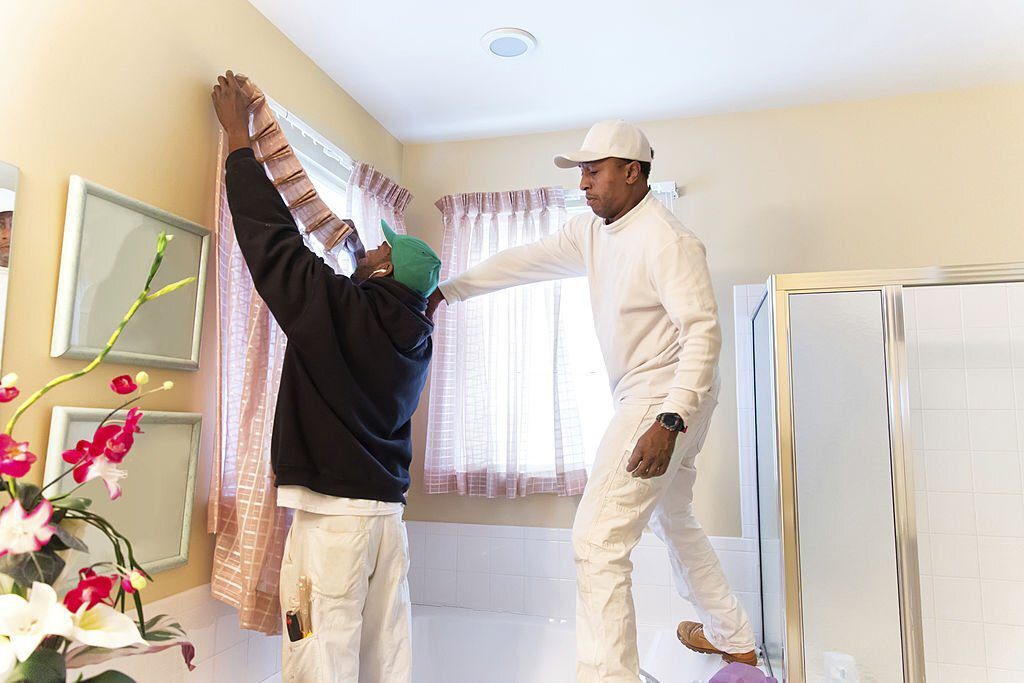
It’s important to note that the type of screws used for this process will depend on the material of the wall and the weight of the curtains. For instance, if you’re hanging heavier curtains, you may want to consider using toggle bolts instead of regular screws.
Once you’ve attached the rod, give it a gentle shake to confirm that it’s securely in place. You don’t want the rod slipping out of the brackets or crashing down with the weight of your curtains. With the rod in place, you’re now ready to hang your curtains and enjoy your newly decorated space.
Step 5: Hang the curtains
The final step is to hang your curtains. Gently thread your curtains onto your rod, ensuring they’re evenly distributed. If your curtains have loops, pass the rod through them. If they have hooks, attach them to the rings on the rod. Make sure the curtains are facing the correct direction, with the pattern or colored side facing outward.
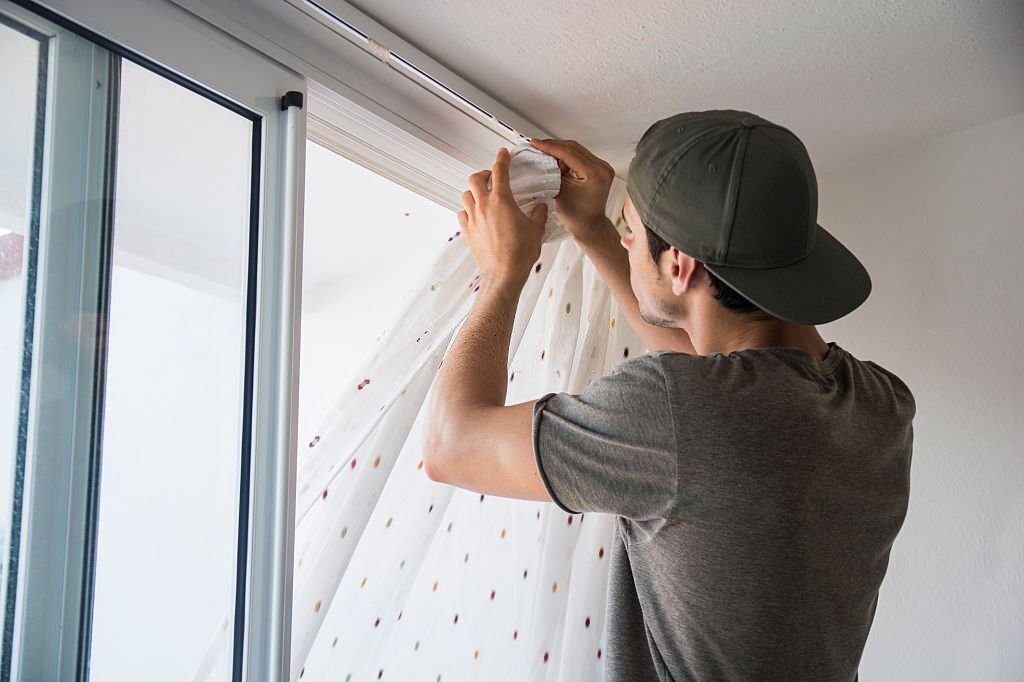
Once the curtains are on the rod, carefully lift the rod (with the curtains) and place it back into the brackets. If your rod has a locking mechanism, make sure it’s secure. Finally, adjust your curtains as needed to create the desired look and effect. You can fluff them, spread them, or tie them back to your liking.
Step 6: Adjust and admire
Once your curtains are hung, take a step back and admire your handiwork. This is the time to make any final adjustments. If the curtains are bunched up, spread them out evenly across the rod. If they are too long or too short, adjust them as necessary. You may need to steam or iron the curtain fabric to remove any wrinkles.
Furthermore, make sure the curtains align well with your window and room aesthetics. Don’t rush this step, as small adjustments can make a big difference in the overall appearance. Remember, your curtains are not just functional but also a key element of your room’s decor. So, take the time to ensure they look just perfect.
Frequently Asked Questions
Why would I need to hang curtains from a slanted ceiling?
Slanted ceilings are a common feature in attics, loft conversions, and top-floor apartments. Curtains can help to provide privacy, block sunlight, and add style to this area of your home.
What type of curtains are best for hanging on slanted ceilings?
Curtains with grommets or rod pockets are the easiest to hang on a slanted ceiling. These types of curtains are also more flexible and can be easily adjusted to fit the unique angles of your ceiling.
How do I choose the right curtain rod for a slanted ceiling?
Look for a flexible, adjustable curtain rod that can be mounted to the slanted ceiling with brackets. Make sure the rod can support the weight of your curtains and is long enough to cover the entire window.
How do I mount the brackets for the curtain rod on a slanted ceiling?
Use a level to ensure that the brackets are mounted straight and even on the slanted ceiling. You may need to use special anchors or screws depending on the type of ceiling material.
Can I use a tension rod to hang curtains on a slanted ceiling?
No, tension rods are not recommended for slanted ceilings as they may not be able to support the weight of the curtains.
How far apart should I space the brackets for my curtain rod on a slanted ceiling?
The brackets should be spaced evenly along the length of the curtain rod. The exact distance will depend on the length and weight of your curtains.
How do I ensure that the curtains hang evenly on a slanted ceiling?
Use a level to make sure that the curtain rod is mounted straight and even. You can also adjust the length of each individual panel to ensure that they hang evenly.
Can I Use Multiple Curtain Panels On A Slanted Ceiling?
Yes, curtain rings can be used to hang curtains on a slanted ceiling. However, make sure that the rings are securely attached to the curtain rod to prevent them from slipping.
Final Thoughts
Hanging curtains on a slanted ceiling may present a unique challenge, but with the right tools and approach, you can successfully transform your space, giving it a stylish and cozy vibe. Remember, patience and attention to detail are crucial during the process. Don’t hesitate to seek professional advice or assistance if you feel overwhelmed. As a parting thought, consider the curtain material and color in addition to its functionality – a harmonious blend of these factors can drastically uplift the aesthetics of a room. Happy decorating.

I am Stacy Roberts, an experienced curtains expert. I spend most of my time writing about curtain design for various magazines and websites, including writing many blog posts on the topic for Homepicks24.com. I love helping people find the perfect curtains for their homes and take great pride in my work. When I'm not writing or helping people choose curtains, I enjoy spending time with my wife and two young children. I also love playing tennis and going to the beach. I believe that having a beautiful home with well-chosen curtains is essential to creating a special atmosphere of comfort and serenity, and thus I strive to help people find the right window treatment for their homes.



